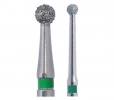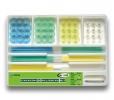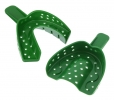|
Researchers have uncovered the genetic sources of dental traits commonly found in East Asians, including upper central incisor shoveling, enamel extensions of the first maxillary molar, and 4-cusped second mandibular molars. These variations can be traced to the human kallikrein cluster (KLK), comprising 15 genes found on chromosome 19. KLK4 has a recognized role in tooth enamel maturation. It cleaves enamelin, a component of tooth enamel, which increases the mineralization levels and thicknesses of the outer surfaces of teeth. But amelogenesis imperfecta (2A1), a genetic condition caused by KLK4 loss of function mutation, is associated with abnormal tooth development and enamel hypomaturation, brownish hyper-pigmentation, and hyper-sensitivity to hot and cold stimuli. The researchers performed a detailed evaluation of KLK3-KLK5 variability in the samples from the 1000 Genomes project from East Asia, Europe, and Africa, sustained by their own sequencing. By doing so, they identified 2 genetic variants (rs198968_T and rs17800874_A) that synergistically operate to reduce KLK4 expression. While the chromosomes carrying both variants are highly prevalent in Asians (65%), they are found at very low frequencies (5%) in other populations like Europeans. “By reducing KLK4 activity, these variants may contribute to the outer surface shape and structure of teeth, which is established during enamel development,” said Susana Seixas of the Institute of Molecular Pathology and Immunology of the University of Porto in Portugal. “It is interesting to note that one of these variants was already associated by other authors to reduce protection against early childhood caries.”
Source :ORIGINAL SOURCE
|
-
منوی اصلیبستن
-
Dental
-
-
-
Gloves
-
-
-
Gloves
-
-
-
Gloves
-
-
-
Gloves
-
-
-
Dental Finishing & Polishing
-
-
-
Gloves
-
-
-
Gloves
-
-
-
Gloves
-
-
-
Gloves
-
-
-
Gloves
-
-
-
Gloves
-
-
-
-
Gloves
-
-
-
Gloves
-
-
-
Gloves
-
-
-
-
-
Gloves
-
-
-
Gloves
-
-
-
Gloves
-
-
-
Gloves
-
-
-
Gloves
-
-
-
Gloves
-
-
-
Gloves
-
-
-
- Mag
-
Laboratory
-
-
Laboratory Equioment
-
-
-
-
Lab
-
-
-
Medical
-
-
-
-
تجهیزات تشخیص
-
تجهیزات عکس برداری
-
-
-
- Help
-
Corporate
-
- Login/ Register
-
منوی اصلیبستن
-
Dental
-
-
-
Gloves
-
-
-
Gloves
-
-
-
Gloves
-
-
-
Gloves
-
-
-
Dental Finishing & Polishing
-
-
-
Gloves
-
-
-
Gloves
-
-
-
Gloves
-
-
-
Gloves
-
-
-
Gloves
-
-
-
Gloves
-
-
-
-
Gloves
-
-
-
Gloves
-
-
-
Gloves
-
-
-
-
-
Gloves
-
-
-
Gloves
-
-
-
Gloves
-
-
-
Gloves
-
-
-
Gloves
-
-
-
Gloves
-
-
-
Gloves
-
-
-
- Mag
-
Laboratory
-
-
Laboratory Equioment
-
-
-
-
Lab
-
-
-
Medical
-
-
-
-
تجهیزات تشخیص
-
تجهیزات عکس برداری
-
-
-
- Help
-
Corporate
-
- Login/ Register
- Home
- Blog
- Dandal News
- Dental Seminars and News
- Dental Industry News
- East Asian Dental Differences Traced to Gene Cluster
Iran Dentistry Magazine
Blog categories
East Asian Dental Differences Traced to Gene Cluster
Related products
Jota - Diamond Burs - Round - FG

Tor VM - Finishing & Polishing Kit (Stem Disc+Strip)

Tor VM - Wooden Wedges of 6 Types

Taksan - Dr.Roufi Tray



